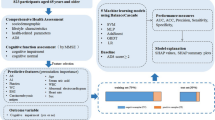Abstract
Several illnesses like the hypertension, the dementia among others in reality contain borderline cases. These “borderline” (alternately mentioned hazy) cases are neither labeled healthy nor diseased by the medical professionals. Consequently, the current diagnostic test methodology is inappropriate for data with the borderline cases. A new methodology is greatly needed to analyze and interpret diagnostic test data with the borderline cases. In this article, a new methodology is therefore developed, discussed, and illustrated. The medical parameters: the sensitivity, the specificity, and the disease prevalence of the sampled participants are calculated and interpreted using the new methodology with data on borderline dementia and blood pressure cases separately.






Similar content being viewed by others
References
Hendrie, H., Osuntokun, B., Hall, K., Ogunniyi, A., Hui, S., Unverzagt, F. et al., The prevalence of Alzheimer’s disease and dementia in two countries of Nigerian Africans and African Americans. Am. J. Geriatr. Psychiatry. 152:1485–1492, 1995.
Lawal, H. B., and Upton, G. J. G., Alternative interaction structures in square contingency table having ordered classificatory variables. Qual. Quant. 24:107–127, 1996.
Lu, Y., and Fan, J. Q., Advanced Medical Statistics. World Scientific, Singapore, 2003.
Zhou, X. H., Obuchowski, N. A., and McClish, D. K., Statistical Methods in Diagnostic Medicine. John Wiley, Hoboken, 2002.
Youden, W. J., Index rating for diagnostic tests. Cancer. 3:32–35, 1950. doi:10.1002/1097-0142(1950)3:1<32::AID-CNCR2820030106>3.0.CO;2-3.
Author information
Authors and Affiliations
Corresponding author
Rights and permissions
About this article
Cite this article
Shanmugam, R. A Diagnostic Methodology for Hazy Data with “Borderline” Cases. J Med Syst 34, 161–177 (2010). https://doi.org/10.1007/s10916-008-9228-7
Received:
Accepted:
Published:
Issue Date:
DOI: https://doi.org/10.1007/s10916-008-9228-7




